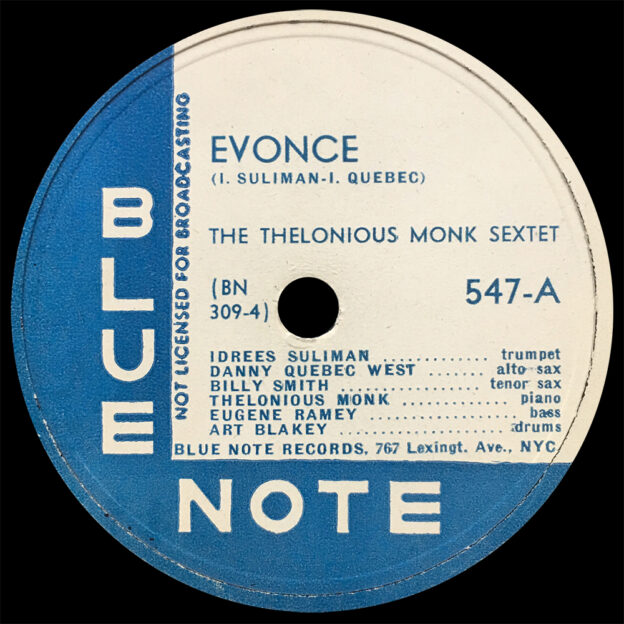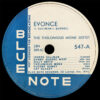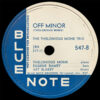- Original 1948 pressing
Personnel:
- Thelonious Monk, piano
- Eugene Ramey, bass
- Art Blakey, drums
“Evonce” Only:
- Idrees Sulieman, trumpet
- Danny Quebec West, alto saxophone
- Billy Smith, tenor saxophone
“Evonce” recorded October 15, 1947
“Off Minor” recorded October 24, 1947
All selections recorded at WOR Studios, New York City
| A | Evonce | |
| B | Off Minor |
Selection:
“Off Minor” (Monk)
Prelude: I’m Baaack
First off, sorry about the flip-flopping regarding the shutting down and reopening of Deep Groove Mono. Last year was an interesting year as a collector. In short, I tried to make some “power moves” in purchasing some expensive records and equipment. Months later, it just didn’t feel right. I felt like I was spending beyond my means, and eventually I would humbly retreat back to being a modest collector of mostly ~$100-or-less discs, a Technics 1200 turntable, and a Shure moving magnet cartridge.
I felt a little defeated and inferior to other collectors who brandish $1,000+ records on the regular, but over time — and this is hard to admit — I found a way to get past the jealousy and irrational shame that came from comparing myself to them. Now I’m back in the saddle and loving collecting more than ever. My spending is more aligned with my means, I appreciate what I have more, and I spend a lot less time obsessing over what I don’t have.
One more thing before we get into the post: I started a new YouTube account where I’m going to start posting “video needledrops” of all my records. Click here to subscribe and keep an eye out for new videos!
My Intro to 78s
For some time now I have wanted to get into collecting 78s. Recently, I began reading Robin D.G. Kelley’s Thelonious Monk biography, and digging into the history of Monk inspired me to seek out the “authentic” experience of hearing his earliest Blue Note recordings on original ten-inch 78 R.P.M. shellac discs opposed to the CD box set I already had (which sounds great, by the way).
 |
| The 2014 double-CD Monk Blue Note “box set” |
Part of my hesitation to jump into 78 collecting was the problem of playing the discs. There are a couple Technics 1200 clones currently on the market that will play 78s (Pioneer, Audio-Technica — thanks to DGM reader Ross for pointing this out) but I might as well just pay to get my 1200 modified to do the same thing. Vintage was also an option, but I have my issues with the quirks commonly plaguing vintage equipment. Then I remembered Califone, the California-based company that manufactured “record players” mainly for use in educational settings through the ’90s, all of which have a 78 setting. Years ago when I first got into collecting jazz LPs, I picked up one of their newer models with the intention of playing beater copies of originals on it, and I was pleasantly surprised by how good those records sounded blasting out of the four-by-ten-inch full-range speaker on the front of the unit.
In theory, that bold, exciting sound has a lot to do with the heavier tracking force of the Califone tonearm, which I understand is in the upwards of six to seven grams. Once I realized this though, I got rid of the player out of fear that it would wear out my LPs.
But then a month ago when I decided I wanted to make the move into 78s, I decided that a Califone would be a great place to start. (Admittedly, I did this assuming that 78s have a higher tolerance for higher tracking forces, and I should probably look further into the matter before I end up ruining anything.) I quickly found a model 1010 AV for cheap locally, a model I chose specifically because it was produced through the ’90s, so any chances of “quirkiness” should have been minimized, and they were. The unit operates as new — surely more wow and flutter than my 1200 and not perfectly silent in operation but blasts out music regardless. And it has a quarter-inch line level output to hook it up to my amplifier and make needledrops. Soon after I got the Califone, I got lucky on Discogs hunting down the beautiful disc being presented here and my 78 experience was ready to begin.
 |
| The Califone 1010 AV |
The 78 Sound
Surely another reason I hesitated to get into 78s was their “inferior” sound quality. Not a high fidelity experience by any stretch of the imagination, the medium nonetheless has an incredibly unique sonic signature. While volunteering at the National Jazz Museum in Harlem recently, Senior Scholar Loren Schoenberg told me that he always felt tenor sax sounded incredible on original 78s, which intrigued me even more.
Once I got a replacement 78 stylus for my Califone (the tip of which is 3 mils opposed to the 1-mil styli for the earliest microgroove LPs), I dropped the thick, weighty 78 onto the Califone’s miniature platter, watched it spin at lightning speed, plopped the needle down onto the disc, and was quickly impressed by the clarity and impact of the sound. Maybe down the road I’ll upgrade by modifying my 1200 to play 78s and then I can get a special 78 cartridge, but for the moment I’m quite happy with this setup.
What a rush hearing Monk in a similar way to how he would have been heard back in 1948. The disc is virtually free of obtrusive pops and ticks, though as is the case with all 78s, you still get a continuous stream of hiss floating above the music. (In the needledrop included here, I attenuated the high frequencies above ~6.5 kHz since that was around where the frequency response of the recording sounded like it started to roll off.) No audible groove wear on this one either, though I have to imagine that groove wear can be an issue with 78s.
The Music
According to the catalog numbers, this was the third Monk 78 released by Blue Note, preceded by 542 “Thelonious” / “Suburban Eyes” and 543 “‘Round Midnight” / “Well, You Needn’t”. For the A-side, Blue Note decided on “Evonce” (slang for marijuana at the time), a tune not accredited to Monk but instead group members Idrees Sulieman and Ike Quebec. The melody line is typical of the zanier melodies in the bebop songwriting tradition. The horns cut through like a butcher knife, though Monk is only awarded half a chorus to solo.
“Off Minor”, the Monk-penned B-side, is the real gem of the disc. Nine days after the recording of side A, the horns stayed home to let the rhythm section do its thing unrestricted in the studio. As with most of Monk’s classic compositions, the first time I ever heard “Off Minor” was not in its original Blue Note incarnation. It was instead on Monk’s Music (Riverside 242). That cleaner recording and bigger ensemble make it a very different version compared to its predecessor. The Riverside version fails to embody the grit and minimalist thrust of this power trio, rounded out by Gene Ramey and a 28 year-old Art Blakey.
On both sides Blakey shuffles, a style of drumming that was a staple of the swing era. Though he doesn’t play with “four on the floor” — the technique that played a major role in defining swing where the drummer would shoulder the bulk of the pulse-keeping responsibility with the bass drum — his cymbal work here nonetheless manages to establish a similar feel. Many bebop drummers in the ’40s (Kenny Clarke, Max Roach) broke with this rhythmic tradition by handing the task of pulse-keeping off to the bassist and instead chose to focus on establishing a sense of swing with the ride cymbal while providing unpredictable excitement with intermittent bass drum “bombs”. Though the bebop movement was well underway in 1947, shuffling apparently wasn’t a completely dated technique yet.
These early Monk recordings cannot be beat for the undeniable hunger and passion emitted by the pianist. Through the lo-fi sound we hear an inspired composer aggressively striking the keyboard, shocking the jazz community with a style of playing so foreign it would take nine more years before Monk would achieve widespread acceptance with the release of Brilliant Corners.



